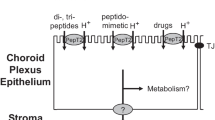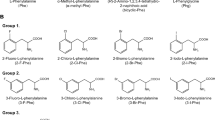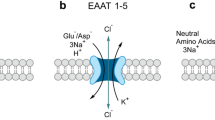Abstract
The previous studies demonstrated that carnosine (β-alanyl-l-histidine) inhibits the growth of tumor cells in vitro and in vivo. Considering carnosine for the treatment of glioblastoma, we investigated which proton-coupled oligopeptide transporters (POTs) are present in glioblastoma cells and how they contribute to the uptake of carnosine. Therefore, mRNA expression of the four known POTs (PEPT1, PEPT2, PHT1, and PHT2) was examined in three glioblastoma cell lines, ten primary tumor cell cultures, in freshly isolated tumor tissue and in healthy brain. Using high-performance liquid chromatography coupled to mass spectrometry, the uptake of carnosine was investigated in the presence of competitive inhibitors and after siRNA-mediated knockdown of POTs. Whereas PEPT1 mRNA was not detected in any sample, expression of the three other transporters was significantly increased in tumor tissue compared to healthy brain. In cell culture, PHT1 expression was comparable to expression in tumor tissue, PHT2 exhibited a slightly reduced expression, and PEPT2 expression was reduced to normal brain tissue levels. In the cell line LN405, the competitive inhibitors β-alanyl-l-alanine (inhibits all transporters) and l-histidine (inhibitor of PHT1/2) both inhibited the uptake of carnosine. SiRNA-mediated knockdown of PHT1 and PHT2 revealed a significantly reduced uptake of carnosine. Interestingly, despite its low expression at the level of mRNA, knockdown of PEPT2 also resulted in decreased uptake. In conclusion, our results demonstrate that the transporters PEPT2, PHT1, and PHT2 are responsible for the uptake of carnosine into glioblastoma cells and full function of all three transporters is required for maximum uptake.



Similar content being viewed by others
References
Abraham D, Pisano JJ, Udenfriend S (1962) The distribution of homocarnosine in mammals. Arch Biochem Biophys 99:210–213. https://doi.org/10.1016/0003-9861(62)90002-4
Bauchart C, Savary-Auzeloux I, Patureau Mirand P, Thomas E, Morzel M, Remond D (2007) Carnosine concentration of ingested meat affects carnosine net release into the portal vein of minipigs. J Nutr 137:589–593
Bellia F, Vecchio G, Rizzarelli E (2014) Carnosinases, their substrates and diseases. Molecules 19:2299–2329. https://doi.org/10.3390/molecules19022299
Boldyrev AA, Aldini G, Derave W (2013) Physiology and pathophysiology of carnosine. Physiol Rev 93:1803–1845. https://doi.org/10.1152/physrev.00039.2012
Brandsch M, Knütter I, Bosse-Doenecke E (2008) Pharmaceutical and pharmacological importance of peptide transporters. J Pharm Pharmacol 60:543–585. https://doi.org/10.1211/jpp.60.5.0002
Csámpai A, Kutlán D, Tóth F, Molnár-Perl I (2004) o-Phthaldialdehyde derivatization of histidine: stoichiometry, stability and reaction mechanism. J Chromatogr A 1031:67–78
Daniel H, Kottra G (2004) The proton oligopeptide cotransporter family SLC15 in physiology and pharmacology. Pflügers Archiv Eur J Physiol 447:610–618. https://doi.org/10.1007/s00424-003-1101-4
Dieck ST, Heuer H, Ehrchen J, Otto C, Bauer K (1999) The peptide transporter PepT2 is expressed in rat brain and mediates the accumulation of the fluorescent dipeptide derivative beta-Ala-Lys-Nepsilon-AMCA in astrocytes. Glia 25:10–20
Ditte Z, Ditte P, Labudova M, Simko V, Iuliano F, Zatovicova M, Csaderova L, Pastorekova S, Pastorek J (2014) Carnosine inhibits carbonic anhydrase IX-mediated extracellular acidosis and suppresses growth of HeLa tumor xenografts. BMC Cancer 14:358. https://doi.org/10.1186/1471-2407-14-358
Everaert I, de Naeyer H, Taes Y, Derave W (2013) Gene expression of carnosine-related enzymes and transporters in skeletal muscle. Eur J Appl Physiol 113:1169–1179. https://doi.org/10.1007/s00421-012-2540-4
Fagerberg L, Hallström BM, Oksvold P, Kampf C, Djureinovic D, Odeberg J, Habuka M, Tahmasebpoor S, Danielsson A, Edlund K, Asplund A, Sjöstedt E, Lundberg E, Szigyarto CA-K, Skogs M, Takanen JO, Berling H, Tegel H, Mulder J, Nilsson P, Schwenk JM, Lindskog C, Danielsson F, Mardinoglu A, Sivertsson A, von Feilitzen K, Forsberg M, Zwahlen M, Olsson I, Navani S, Huss M, Nielsen J, Ponten F, Uhlén M (2014) Analysis of the human tissue-specific expression by genome-wide integration of transcriptomics and antibody-based proteomics. Mol Cell Proteom 13:397–406. https://doi.org/10.1074/mcp.M113.035600
Fujita T, Kishida T, Wada M, Okada N, Yamamoto A, Leibach FH, Ganapathy V (2004) Functional characterization of brain peptide transporter in rat cerebral cortex: identification of the high-affinity type H +/peptide transporter PEPT2. Brain Res 997:52–61. https://doi.org/10.1016/j.brainres.2003.10.049
Gaunitz F, Hipkiss AR (2012) Carnosine and cancer: a perspective. Amino Acids 43:135–142. https://doi.org/10.1007/s00726-012-1271-5
Gaunitz F, Oppermann H, Hipkiss AR (2015) Carnosine and Cancer. In: Preedy VR (ed) Imidazole dipeptides. The Royal Society of Chemistry, Cambridge, pp 372–392
Gulewitsch W, Amiradzibi S (1900) Ueber das carnosin, eine neue organische Base des Fleischextraktes. Ber Dtsch Chem Ges 33:1902–1903
Herrera-Ruiz D, Wang Q, Cook TJ, Knipp GT, Gudmundsson OS, Smith RL, Faria TN (2001) Spatial expression patterns of peptide transporters in the human and rat gastrointestinal tracts, Caco-2 In Vitro cell culture model, and multiple human tissues. AAPS PharmSci 3:100–111. https://doi.org/10.1208/ps030109
Hipkiss AR, Gaunitz F (2013) Inhibition of tumour cell growth by carnosine: some possible mechanisms. Amino Acids. https://doi.org/10.1007/s00726-013-1627-5
Horii Y, Shen J, Fujisaki Y, Yoshida K, Nagai K (2012) Effects of l-carnosine on splenic sympathetic nerve activity and tumor proliferation. Neurosci Lett 510:1–5. https://doi.org/10.1016/j.neulet.2011.12.058
Hu Y, Song F, Jiang H, Nuñez G, Smith DE (2018) SLC15A2 and SLC15A4 mediate the transport of bacterially derived di/tripeptides to enhance the nucleotide-binding oligomerization domain-dependent immune response in mouse bone marrow-derived macrophages. J Immunol 201:652–662. https://doi.org/10.4049/jimmunol.1800210
Jappar D, Hu Y, Keep RF, Smith DE (2009) Transport mechanisms of carnosine in SKPT cells: contribution of apical and basolateral membrane transporters. Pharm Res 26:172–181. https://doi.org/10.1007/s11095-008-9726-9
Kamal MA, Jiang HD, Hu YJ, Keep RF, Smith DE (2009) Influence of genetic knockout of Pept2 on the in vivo disposition of endogenous and exogenous carnosine in wild-type and Pept2 null mice. Am J Physiol Regul Comp Physiol 296:R986–R991
Lee J, Tattoli I, Wojtal KA, Vavricka SR, Philpott DJ, Girardin SE (2009) pH-dependent internalization of muramyl peptides from early endosomes enables Nod1 and Nod2 signaling. J Biol Chem 284:23818–23829. https://doi.org/10.1074/jbc.M109.033670
Letzien U, Oppermann H, Meixensberger J, Gaunitz F (2014) The antineoplastic effect of carnosine is accompanied by induction of PDK4 and can be mimicked by l-histidine. Amino Acids. https://doi.org/10.1007/s00726-014-1664-8
Lin H, King N (2007) Demonstration of functional dipeptide transport with expression of PEPT2 in guinea pig cardiomyocytes. Pflgers Archiv Eur J Physiol 453:915–922. https://doi.org/10.1007/s00424-006-0171-5
Mannion AF, Jakeman PM, Dunnett M, Harris RC, Willan PL (1992) Carnosine and anserine concentrations in the quadriceps femoris muscle of healthy humans. Eur J Appl Physiol Occup Physiol 64:47–50
Ogihara H, Saito H, Shin BC, Terado T, Takenoshita S, Nagamachi Y, Inui K, Takata K (1996) Immuno-localization of H +/peptide cotransporter in rat digestive tract. Biochem Biophys Res Commun 220:848–852
Oppermann H, Schnabel L, Meixensberger J, Gaunitz F (2016) Pyruvate attenuates the anti-neoplastic effect of carnosine independently from oxidative phosphorylation. Oncotarget 7:85848–85860. https://doi.org/10.18632/oncotarget.13039
Oppermann H, Dietterle J, Purcz K, Morawski M, Eisenlöffel C, Müller W, Meixensberger J, Gaunitz F (2018) Carnosine selectively inhibits migration of IDH-wildtype glioblastoma cells in a co-culture model with fibroblasts. Cancer Cell Int 18:111. https://doi.org/10.1186/s12935-018-0611-2
Oppermann H, Alvanos A, Seidel C, Meixensberger J, Gaunitz F (2019a) Carnosine influences transcription via epigenetic regulation as demonstrated by enhanced histone acetylation of the pyruvate dehydrogenase kinase 4 promoter in glioblastoma cells. Amino Acids. https://doi.org/10.1007/s00726-018-2619-2
Oppermann H, Purcz K, Birkemeyer C, Baran-Schmidt R, Meixensberger J, Gaunitz F (2019b) Carnosine’s inhibitory effect on glioblastoma cell growth is independent of its cleavage. Amino Acids. https://doi.org/10.1007/s00726-019-02713-6
Ostrom QT, Gittleman H, Xu J, Kromer C, Wolinsky Y, Kruchko C, Barnholtz-Sloan JS (2016) CBTRUS statistical report: primary brain and other central nervous system tumors diagnosed in the United States in 2009–2013. Neuro Oncol 18:v1–v75. https://doi.org/10.1093/neuonc/now207
Parker JL, Li C, Brinth A, Wang Z, Vogeley L, Solcan N, Ledderboge-Vucinic G, Swanson JMJ, Caffrey M, Voth GA, Newstead S (2017) Proton movement and coupling in the POT family of peptide transporters. Proc Natl Acad Sci USA 114:13182–13187. https://doi.org/10.1073/pnas.1710727114
Renner C, Seyffarth A, de Arriba S, Meixensberger J, Gebhardt R, Gaunitz F (2008) Carnosine inhibits growth of cells isolated from human glioblastoma multiforme. Int J Pept Res Ther 14:127–135. https://doi.org/10.1007/s10989-007-9121-0
Renner C, Zemitzsch N, Fuchs B, Geiger KD, Hermes M, Hengstler J, Gebhardt R, Meixensberger J, Gaunitz F (2010) Carnosine retards tumor growth in vivo in an NIH3T3-HER2/neu mouse model. Mol Cancer 9:2. https://doi.org/10.1186/1476-4598-9-2
Rubio-Aliaga I, Daniel H (2008) Peptide transporters and their roles in physiological processes and drug disposition. Xenobiotica 38:1022–1042. https://doi.org/10.1080/00498250701875254
Sakata K, Yamashita T, Maeda M, Moriyama Y, Shimada S, Tohyama M (2001) Cloning of a lymphatic peptide/histidine transporter. Biochem J 356:53–60
Sant M, Minicozzi P, Lagorio S, Børge Johannesen T, Marcos-Gragera R, Francisci S (2012) Survival of European patients with central nervous system tumors. Int J Cancer 131:173–185. https://doi.org/10.1002/ijc.26335
Shen Y, Yang J, Li J, Shi X, Ouyang L, Tian Y, Lu J (2014) Carnosine inhibits the proliferation of human gastric cancer SGC-7901 cells through both of the mitochondrial respiration and glycolysis pathways. PLoS One 9:e104632. https://doi.org/10.1371/journal.pone.0104632
Smith DE, Clémençon B, Hediger MA (2013) Proton-coupled oligopeptide transporter family SLC15: physiological, pharmacological and pathological implications. Mol Aspects Med 34:323–336. https://doi.org/10.1016/j.mam.2012.11.003
Son DO, Satsu H, Kiso Y, Shimizu M (2004) Characterization of carnosine uptake and its physiological function in human intestinal epithelial Caco-2 cells. BioFactors 21:395–398
Teuscher NS, Shen H, Shu C, Xiang JM, Keep RF, Smith DE (2004) Carnosine uptake in rat choroid plexus primary cell cultures and choroid plexus whole tissue from PEPT2 null mice. J Neurochem 89:375–382
The GTEx Consortium (2015) Human genomics. the genotype-tissue expression (GTEx) pilot analysis: multitissue gene regulation in humans. Science 348:648–660. https://doi.org/10.1126/science.1262110
Uhlén M, Fagerberg L, Hallström BM, Lindskog C, Oksvold P, Mardinoglu A, Sivertsson Å, Kampf C, Sjöstedt E, Asplund A, Olsson I, Edlund K, Lundberg E, Navani S, Szigyarto CA-K, Odeberg J, Djureinovic D, Takanen JO, Hober S, Alm T, Edqvist P-H, Berling H, Tegel H, Mulder J, Rockberg J, Nilsson P, Schwenk JM, Hamsten M, von Feilitzen K, Forsberg M, Persson L, Johansson F, Zwahlen M, von Heijne G, Nielsen J, Pontén F (2015) Proteomics. Tissue-based map of the human proteome. Science 347:1260419. https://doi.org/10.1126/science.1260419
Xiang J, Hu Y, Smith DE, Keep RF (2006) PEPT2-mediated transport of 5-aminolevulinic acid and carnosine in astrocytes. Brain Res 1122:18–23. https://doi.org/10.1016/j.brainres.2006.09.013
Yamashita T, Shimada S, Guo W, Sato K, Kohmura E, Hayakawa T, Takagi T, Tohyama M (1997) Cloning and functional expression of a brain peptide/histidine transporter. J Biol Chem 272:10205–10211. https://doi.org/10.1074/jbc.272.15.10205
Zimmermann M, Stan AC (2010) PepT2 transporter protein expression in human neoplastic glial cells and mediation of fluorescently tagged dipeptide derivative β-Ala-Lys-Nepsilon-7-amino-4-methyl-coumarin-3-acetic acid accumulation. J Neurosurg 112:1005–1014. https://doi.org/10.3171/2009.6.JNS08346
Acknowledgements
We like to thank Flamma [Flamma s.p.a. Chignolo d’Isola, Italy (http://www.flammagroup.com)] for the generous supply with very high-quality carnosine for all of our experiments. In addition, we like to thank Dr. Hans-Heinrich Foerster from the Genolytic GmbH (Leipzig, Germany) for genotyping and confirmation of cell identity and last not least Mr. Rainer Baran-Schmidt for technical assistance.
Author information
Authors and Affiliations
Contributions
MH and HO performed the experiments. CB and HO established the HPLC–MS method and performed the HPLC–MS measurements. JM did the surgery and revised the manuscript. HO and FG designed and coordinated the experiments. FG, MH, and HO wrote the manuscript. All authors read and approved the manuscript.
Corresponding author
Ethics declarations
Conflict of interest
The authors declare that they have no potential conflict of interest.
Informed consent
All patients provided written informed consent according to German law as confirmed by the local committee (#144-2008) in accordance with the 1964 Helsinki declaration and its later amendments.
Additional information
Handling Editor: E. Closs.
Publisher's Note
Springer Nature remains neutral with regard to jurisdictional claims in published maps and institutional affiliations.
Electronic supplementary material
Below is the link to the electronic supplementary material.
726_2019_2739_MOESM1_ESM.jpg
Supplementary material 1 Comparison of expression of POTs in human tissues. The expression of individual transporters in percent with regard to the expression of all reporters (set as 100%) was calculated using the data from Fagerberg et al., (Fagerberg et al. 2014) which is available as FPKM (fragments per kilobase of exon model per million mapped reads) (JPEG 2457 kb)
726_2019_2739_MOESM2_ESM.docx
Supplementary material 2 Primers used for qRT-PCR. Indicated are the target genes and the sequences of the employed forward and reverse primers (DOCX 14 kb)
Rights and permissions
About this article
Cite this article
Oppermann, H., Heinrich, M., Birkemeyer, C. et al. The proton-coupled oligopeptide transporters PEPT2, PHT1 and PHT2 mediate the uptake of carnosine in glioblastoma cells. Amino Acids 51, 999–1008 (2019). https://doi.org/10.1007/s00726-019-02739-w
Received:
Accepted:
Published:
Issue Date:
DOI: https://doi.org/10.1007/s00726-019-02739-w




